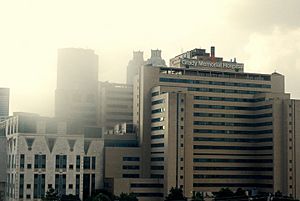Grady Memorial Hospital facts for kids
Quick facts for kids Grady Memorial Hospital |
|
|---|---|
 |
|
 |
|
| Geography | |
| Location | Atlanta, Georgia, United States |
| Coordinates | 33°45′08″N 84°22′57″W / 33.752221°N 84.382392°W |
| Organization | |
| Care system | Public |
| Hospital type | General |
| Affiliated university | Emory University School of Medicine Morehouse School of Medicine |
| Services | |
| Emergency department | Level I trauma center |
| Beds | 989 |
| History | |
| Founded | 1892 |
Grady Memorial Hospital is a very important public hospital in Atlanta, Georgia. It is one of the ten largest public hospitals in the United States. This hospital is also a Level I trauma center, which means it is ready to handle the most serious injuries and emergencies.
Hospital History
Grady Memorial Hospital started in 1890 and opened its doors in 1892. It grew from a place called the Atlanta Benevolent Home. The hospital is named after Henry W. Grady, a journalist and newspaper owner. He was a big supporter of having a public hospital for the city.
When it first opened, the hospital had 14 rooms. The very first building is now called Georgia Hall. It is a historic building where the hospital's human resources staff work today. Over the years, Grady Hospital moved to different locations. The hospital you see today is its fourth main building.
For many years, from 1945 until 2008, the hospital was managed by the Fulton/DeKalb Hospital Authority.
Changes and Improvements
In 2007 and 2008, Grady Memorial Hospital faced some money problems. Many people worked hard to help save it from closing. A journalist named Mike King wrote many articles about "Saving Grady."
In 2008, Grady Hospital became a non-profit organization. This means it uses its money to help people, not to make a profit for owners. Many groups promised money to help the hospital get better. Michael Young became the new chief executive officer. He had experience leading other large hospitals.
By February 2013, Grady Hospital was doing much better financially. It had made a profit of $20 million and added hundreds of new jobs.
2008 Tornado Event
On March 14, 2008, a tornado hit downtown Atlanta. The buildings at Grady Hospital had some minor damage. The historic Georgia Hall was hit the hardest. Its windows broke, a chimney fell, and there was water damage. The main hospital building had a few cafeteria windows break, but it never lost power. This was the first tornado to hit downtown Atlanta since records began in the 1880s. Nine people were taken to Grady for treatment after the storm.
Hospital Services
Grady Hospital helps many patients who have low incomes. It gets most of its support from Fulton and DeKalb counties. Even though it serves the entire metro Atlanta region, it gets little help from other areas or the state.
The hospital works closely with Emory University School of Medicine and Morehouse School of Medicine. These universities provide many of the doctors and medical residents who work at Grady. So, when you hear about a "Grady doctor," it often means they are also an "Emory doctor" or a "Morehouse doctor."
Grady Hospital also has its own ambulance service, called Grady EMS. This service helps with 9-1-1 calls in Fulton County, Georgia. The main highway in Atlanta, the Downtown Connector (Interstate 75/85), curves around the hospital. This curve is often called the "Grady Curve" in traffic reports.
See also
- List of public hospitals in the United States

